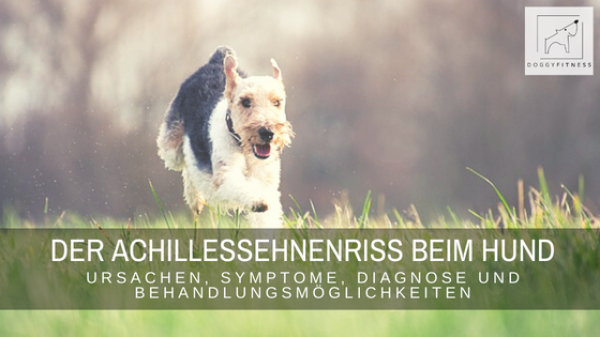Have you ever heard of a ruptured Achilles tendon in a dog? The Achilles tendon is the strongest tendon in the body. It includes tendons of flexors of the knee joint and extensors of the ankle joint, as well as the toe flexors. Their function is to transfer the force of the calf muscles to the hind paw. With every step the dog takes, it is subjected to extreme stress. Especially for jumps, by the way. The Achilles tendon is therefore characterized by a particular thickness and tensile strength. Complaints of the Achilles tendon often come insidiously.
The rupture of the Achilles tendon is possible in the dog as well as in the cat, but it is rather rare. However, the treatment is very possible. Consistent immobilization is particularly important during the healing phase, which is usually the greatest challenge. Then again, gentle mobilization is very important for healthy movement and weight bearing on the affected hind leg.
How does the rupture of the Achilles tendon occur in dogs
On the one hand, the tear can be caused by acute trauma. But also due to chronic overload and thus progressive wear and tear. The tendon continues to tear successively until partial or complete rupture.
The symptoms Achilles tendon rupture in dog
Characteristically, affected dogs put less stress on the barrel. In the event of a load, the ankle joint is bent significantly more. If the tendon is completely torn, one also speaks of a “rabbit’s foot”, since no longer only the paw is put on, but the metatarsal bone is also put down.
How can an Achilles tendon rupture be diagnosed in dogs?
A clinical and orthopedic examination course are essential. The Achilles tendon is controlled by keeping the knee in an extended position, the ankle is flexed. Then the Achilles tendon is palpated. You can feel them yourself on your dog. It is a firm palpable cord. In the case of a tear, the attending physician will feel swelling in the examination, for example. If it is completely torn, there is no more tension on the tendon cord. In the case of a partial tear, “only” a swelling is usually palpable in the area of the tear site
X-ray examinations, ultrasound or a CT scan are usually used for diagnosis.
The following diseases must be ruled out when making the diagnosis:
- Hypothyroidism
- diabetic neuropathy
- congenital hyperflexion
- Calcaneus fracture
- Ischiadicus injury
The treatment Achilles tendon rupture in dogs
Therapy of the Achilles tendon can be either conservative or surgical. In the case of a partial tear, the chance of success is significantly greater. In the case of a complete tear, surgery and fixation of the Achilles tendon are usually unavoidable. Especially if bone fragments were also detached. Achilles tendon rupture in dog
Conservative treatment is as follows:
Immobilization of the ankle, box rest and physiotherapy. In detail, this means that the affected run is immobilized by means of a plaster cast, splint, an external fixator or calcaneotibial set screw. Immobilization is usually necessary for 3-4 weeks (sometimes longer), after which successive physiotherapeutic mobilization is performed. During the period of box rest, the affected dog should be kept absolutely quiet. That means getting out briefly to get unstuck. All, of course, on the leash at walking pace. Jumping on the bed/sofa, playing with other dogs and any form of stress are taboo.
Physiotherapeutically, overloaded structures and tensions should be relaxed and loosened, mobility and musculature of the other three runs should be maintained. To maintain the muscles are suitable, for example, isometric exercises and also exercises with weight shifts. Achilles tendon rupture in dog
The surgical treatment
In the case of a complete rupture, as described, it is usually necessary to treat the tear surgically. For this purpose, there are different procedures for suturing the torn tendon ends together again. Here, too, immobilization by means of a fixator, plaster cast, splint or similar is indispensable. Furthermore, the dog is kept quiet during the recovery phase with box rest and accompanied with physiotherapy. After the healing is completed, physiotherapeutic mobilization takes place. In the postoperative phase, the same applies as for conservative immobilization.
In particular, the immobilization phase is very challenging for most dog people. If your dog has been affected by a ruptured Achilles tendon, you’ll find helpful tips for the healing phase in this article that will make this time much easier for you and your dog.
All love,
your Tina
Dieser Beitrag ist auch verfügbar auf:
Français (French)
Deutsch (German)
Español (Spanish)
















